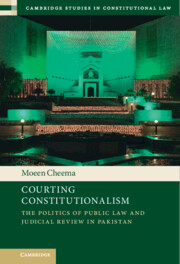Book contents
- Courting Constitutionalism
- Cambridge Studies in Constitutional Law
- Courting Constitutionalism
- Copyright page
- Dedication
- Contents
- Acknowledgements
- Table of Cases
- 1 Introduction
- 2 Postcolonial Legality
- 3 Martial Rule
- 4 Elective Dictatorship
- 5 Praetorian Governmentality
- 6 Indirect Praetorianism
- 7 Military–Civil Composite
- 8 Corporatist Governance
- 9 Conclusion
- Bibliography
- Index
7 - Military–Civil Composite
‘Military Incorporated’ and the ‘Lawyers’ Movement’
Published online by Cambridge University Press: 16 December 2021
- Courting Constitutionalism
- Cambridge Studies in Constitutional Law
- Courting Constitutionalism
- Copyright page
- Dedication
- Contents
- Acknowledgements
- Table of Cases
- 1 Introduction
- 2 Postcolonial Legality
- 3 Martial Rule
- 4 Elective Dictatorship
- 5 Praetorian Governmentality
- 6 Indirect Praetorianism
- 7 Military–Civil Composite
- 8 Corporatist Governance
- 9 Conclusion
- Bibliography
- Index
Summary
Chapter 7 dissects the subtle shifts in state structure and power relations during the third cycle of military rule in Pakistan which for the first time was characterised by a successful hybridity of a military–civil composite. When General Pervez Musharraf overthrew an elected government in October 1999 the familiar architecture of military rule was resurrected. However, unlike previous military regimes General Musharraf was successful in holding elections and managing a symbiotic relationship with a civilian government whereby a semblance of democratic governance could be upheld. The Supreme Court once again validated the military takeover and the continuity of judicial review of executive action initially aligned with the regime’s proclaimed agenda of the structural reform of the state and anti-corruption drive. However, when Chief Justice Iftikhar Chaudhry assumed office in 2005 this accommodation between the military-dominated regime and the courts began to fracture. With impending elections in 2007, the regime dismissed the Chief Justice sparking the protest movement by the lawyers that would ultimately pave the way for another transition to civil democratic rule, as well as for the restoration of an assertive ‘Chaudhry Court’.
Keywords
- Type
- Chapter
- Information
- Courting ConstitutionalismThe Politics of Public Law and Judicial Review in Pakistan, pp. 169 - 195Publisher: Cambridge University PressPrint publication year: 2021

